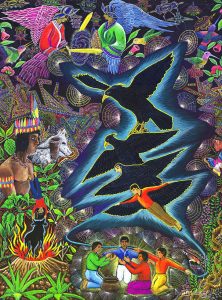The Ayahuasca Experience
Matthew Tigrett
My name is Matthew Tigrett, and welcome to my portfolio “The Ayahuasca Experience”. This chapter is licensed as CC-BY-NC-SA.
Introduction
Pablo Amaringo (1938-2009) was a Peruvian shaman and visionary artist who is revered as a masterful illustrator of the Ayahuasca experience, in which a variety of creatures, buildings, and spacecraft merge to create a stunning ecosystem. The Ayahuasca is an ancient entheogenic brew ritually consumed by the indigenous peoples of the Amazon as a shamanic tradition. Through his intricate and dynamic paintings, Amaringo illustrated everything that was revealed to him by Ayahuasca, which included good and evil spirits, extraterrestrial beings and spaceships, cities, palaces, other realms, sorcerers, and shamans. The Ayahuasca realm is a fantastic universe filled with the energy of the Amazon’s stunning natural landscapes and the mythical content of Amaringo’s visions.
Analysis

“Unicornio Dorado” – Pablo Amaringo, 2003. This painting represents two ceremonies; indigenous peoples and native traditions (left), and non-indigenous peoples and modern civilization (right). The circular horns (huaccra) represent the different paths of knowledge and evolution taken by society in a modernized world. Those who follow the path of the indigenous peoples arrive at the sacred temple more quickly than those who follow the other path. This serves as a testament to the wisdom of indigenous groups and the value of their ancient traditions.

“Transformacion del Chaman en Aguila (Transformation of the Shaman into an Eagle)” – Pablo Amaringo, 2002. This painting depicts a shaman transforming himself into an eagle and flying away to a foreign place, later returning and bringing more knowledge to his people. He catches a glimpse of the past, present, and future and captures the essence of time into one eternal moment. The soaring of the eagle represents human potential to ascend to levels of personal wisdom and mastery with new frontiers of knowledge. This is an illustration of Amaringo’s experience as a shaman in correlation with his Ayahuasca visions.

“Variopinto de la Chacruna” – Pablo Amaringo, 2003. This painting illustrates the contents of Ayahuasca; chacruna and ayahuasca are combined to form the sacred brew. The chacruna is a shrubby flowering plant whose leaves are used in the creation of Ayahuasca. Drinking ayahuasca without chacruna forces the mind to play one’s visions in black and white; ayahuasca only provides the consumer with insight while chacruna is more dynamic and introduces color to one’s visions. The contrast between chacruna and ayahuasca is beautifully illustrated by Amaringo in this piece.
Themes
Identity in nature. Pablo Amaringo found his identity in nature through his life as both a shaman and an artist. Through his training to become a shaman amidst nature, Amaringo discovered the art of healing and used this art to transform himself and others. The botanical landscapes of the Peruvian Amazon on which Amaringo grew up on also served as the backdrop of his stunningly intricate paintings. Amaringo both discovered the art of healing and developed his artistic expressions through nature.
Difficulty in belonging. As indigenous peoples are declining around the world, their coveted rituals and traditions are lost to time. Indigenous peoples may find difficulty in spreading their traditions to other groups and finding cultural belonging. Groups who practice the Ayahuasca brew are no exception; the Shipibo, Conibo, Shetebo, and Amahuaca tribes struggle to find another cultural home outside of their Amazonian sanctuary. Pablo Amaringo’s contributions as both a shaman and an artist make up a large portion of the few well-known representations of the Ayahuasca realm.
Application
The life and legacy of Pablo Amaringo is vital for the remembrace and representation of the Ayahuasca entheogenic brew that was consumed by the indigenous peoples of the Amazon as a shamanic tradition. Born and raised in the Peruvian Amazon, Amaringo held a connection with Ayahuasca from a young age; he tasted Ayahuasca for the first time at ten years old. He later began to train as a curandero (shaman) and discovered the art of healing, with which he healed himself from a severe heart disease and others from their own diseases and ailments. He then gave up his life as a shaman in 1977 and dedicated himself to art. Amaringo’s paintings were intricate, colorful, and dynamic; he would often chant icaros (Shipibo healing ceremonial song) while painting, as though his canvas and paintbrush were medicine. He regarded his paintings as a physical manifestation of icaros, with the power to heal and awaken one’s soul.
Alongside his work as both a shaman and an artist, Amaringo founded the Usko-Ayar School of Painting in his home country of Peru and authored a widely renowned book titled Ayahuasca Visions: The Religious Iconography of a Peruvian Shaman. Pablo Amaringo’s contributions to the Ayahuasca realm as an artist and author serve as a testament to the sacred tradition of Ayahuasca and the indigenous societies that practice it to this day.
Media Attributions
- The-Third-Eye-Magazine_Pablo-Amaringo_Peru-Ayahuasca-Visions-03
- Private: The-Third-Eye-Magazine_Pablo-Amaringo_Peru-Ayahuasca-Visions-06
- Private: 3641741250_77efb5aeb8_o

